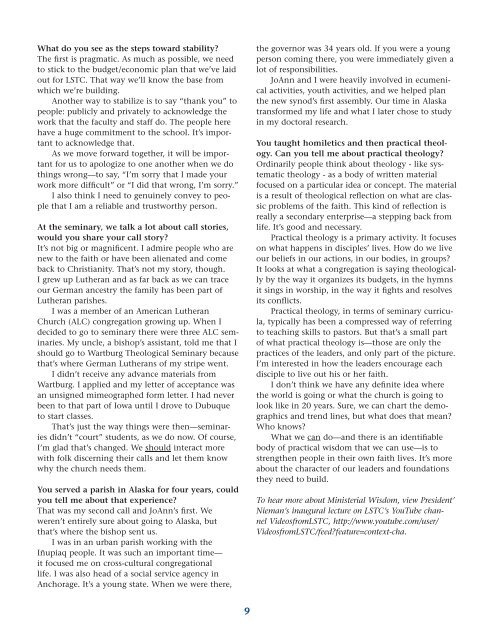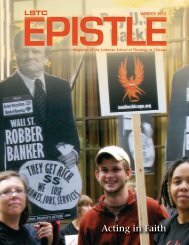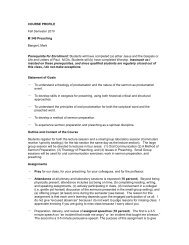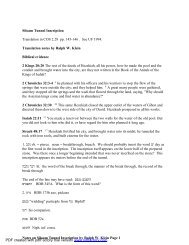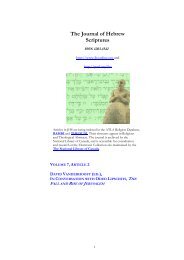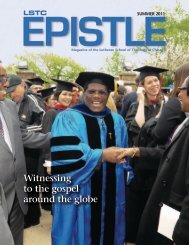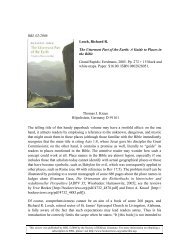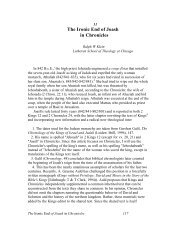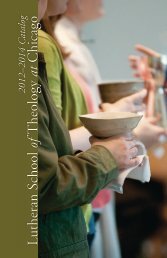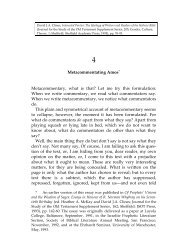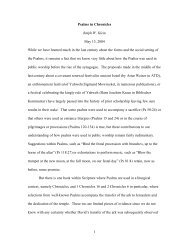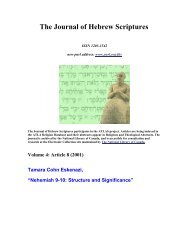Download the magazine here - Lutheran School of Theology at ...
Download the magazine here - Lutheran School of Theology at ...
Download the magazine here - Lutheran School of Theology at ...
- No tags were found...
Create successful ePaper yourself
Turn your PDF publications into a flip-book with our unique Google optimized e-Paper software.
Wh<strong>at</strong> do you see as <strong>the</strong> steps toward stability?The first is pragm<strong>at</strong>ic. As much as possible, we needto stick to <strong>the</strong> budget/economic plan th<strong>at</strong> we’ve laidout for LSTC. Th<strong>at</strong> way we’ll know <strong>the</strong> base fromwhich we’re building.Ano<strong>the</strong>r way to stabilize is to say “thank you” topeople: publicly and priv<strong>at</strong>ely to acknowledge <strong>the</strong>work th<strong>at</strong> <strong>the</strong> faculty and staff do. The people <strong>here</strong>have a huge commitment to <strong>the</strong> school. It’s importantto acknowledge th<strong>at</strong>.As we move forward toge<strong>the</strong>r, it will be importantfor us to apologize to one ano<strong>the</strong>r when we dothings wrong—to say, “I’m sorry th<strong>at</strong> I made yourwork more difficult” or “I did th<strong>at</strong> wrong, I’m sorry.”I also think I need to genuinely convey to peopleth<strong>at</strong> I am a reliable and trustworthy person.At <strong>the</strong> seminary, we talk a lot about call stories,would you share your call story?It’s not big or magnificent. I admire people who arenew to <strong>the</strong> faith or have been alien<strong>at</strong>ed and comeback to Christianity. Th<strong>at</strong>’s not my story, though.I grew up Lu<strong>the</strong>ran and as far back as we can traceour German ancestry <strong>the</strong> family has been part <strong>of</strong>Lu<strong>the</strong>ran parishes.I was a member <strong>of</strong> an American Lu<strong>the</strong>ranChurch (ALC) congreg<strong>at</strong>ion growing up. When Idecided to go to seminary <strong>the</strong>re were three ALC seminaries.My uncle, a bishop’s assistant, told me th<strong>at</strong> Ishould go to Wartburg Theological Seminary becauseth<strong>at</strong>’s w<strong>here</strong> German Lu<strong>the</strong>rans <strong>of</strong> my stripe went.I didn’t receive any advance m<strong>at</strong>erials fromWartburg. I applied and my letter <strong>of</strong> acceptance wasan unsigned mimeographed form letter. I had neverbeen to th<strong>at</strong> part <strong>of</strong> Iowa until I drove to Dubuqueto start classes.Th<strong>at</strong>’s just <strong>the</strong> way things were <strong>the</strong>n—seminariesdidn’t “court” students, as we do now. Of course,I’m glad th<strong>at</strong>’s changed. We should interact morewith folk discerning <strong>the</strong>ir calls and let <strong>the</strong>m knowwhy <strong>the</strong> church needs <strong>the</strong>m.You served a parish in Alaska for four years, couldyou tell me about th<strong>at</strong> experience?Th<strong>at</strong> was my second call and JoAnn’s first. Weweren’t entirely sure about going to Alaska, butth<strong>at</strong>’s w<strong>here</strong> <strong>the</strong> bishop sent us.I was in an urban parish working with <strong>the</strong>Iñupiaq people. It was such an important time—it focused me on cross-cultural congreg<strong>at</strong>ionallife. I was also head <strong>of</strong> a social service agency inAnchorage. It’s a young st<strong>at</strong>e. When we were <strong>the</strong>re,<strong>the</strong> governor was 34 years old. If you were a youngperson coming <strong>the</strong>re, you were immedi<strong>at</strong>ely given alot <strong>of</strong> responsibilities.JoAnn and I were heavily involved in ecumenicalactivities, youth activities, and we helped plan<strong>the</strong> new synod’s first assembly. Our time in Alask<strong>at</strong>ransformed my life and wh<strong>at</strong> I l<strong>at</strong>er chose to studyin my doctoral research.You taught homiletics and <strong>the</strong>n practical <strong>the</strong>ology.Can you tell me about practical <strong>the</strong>ology?Ordinarily people think about <strong>the</strong>ology - like system<strong>at</strong>ic<strong>the</strong>ology - as a body <strong>of</strong> written m<strong>at</strong>erialfocused on a particular idea or concept. The m<strong>at</strong>erialis a result <strong>of</strong> <strong>the</strong>ological reflection on wh<strong>at</strong> are classicproblems <strong>of</strong> <strong>the</strong> faith. This kind <strong>of</strong> reflection isreally a secondary enterprise—a stepping back fromlife. It’s good and necessary.Practical <strong>the</strong>ology is a primary activity. It focuseson wh<strong>at</strong> happens in disciples’ lives. How do we liveour beliefs in our actions, in our bodies, in groups?It looks <strong>at</strong> wh<strong>at</strong> a congreg<strong>at</strong>ion is saying <strong>the</strong>ologicallyby <strong>the</strong> way it organizes its budgets, in <strong>the</strong> hymnsit sings in worship, in <strong>the</strong> way it fights and resolvesits conflicts.Practical <strong>the</strong>ology, in terms <strong>of</strong> seminary curricula,typically has been a compressed way <strong>of</strong> referringto teaching skills to pastors. But th<strong>at</strong>’s a small part<strong>of</strong> wh<strong>at</strong> practical <strong>the</strong>ology is—those are only <strong>the</strong>practices <strong>of</strong> <strong>the</strong> leaders, and only part <strong>of</strong> <strong>the</strong> picture.I’m interested in how <strong>the</strong> leaders encourage eachdisciple to live out his or her faith.I don’t think we have any definite idea w<strong>here</strong><strong>the</strong> world is going or wh<strong>at</strong> <strong>the</strong> church is going tolook like in 20 years. Sure, we can chart <strong>the</strong> demographicsand trend lines, but wh<strong>at</strong> does th<strong>at</strong> mean?Who knows?Wh<strong>at</strong> we can do—and <strong>the</strong>re is an identifiablebody <strong>of</strong> practical wisdom th<strong>at</strong> we can use—is tostreng<strong>the</strong>n people in <strong>the</strong>ir own faith lives. It’s moreabout <strong>the</strong> character <strong>of</strong> our leaders and found<strong>at</strong>ions<strong>the</strong>y need to build.To hear more about Ministerial Wisdom, view President’Nieman’s inaugural lecture on LSTC’s YouTube channelVideosfromLSTC, http://www.youtube.com/user/VideosfromLSTC/feed?fe<strong>at</strong>ure=context-cha.9


